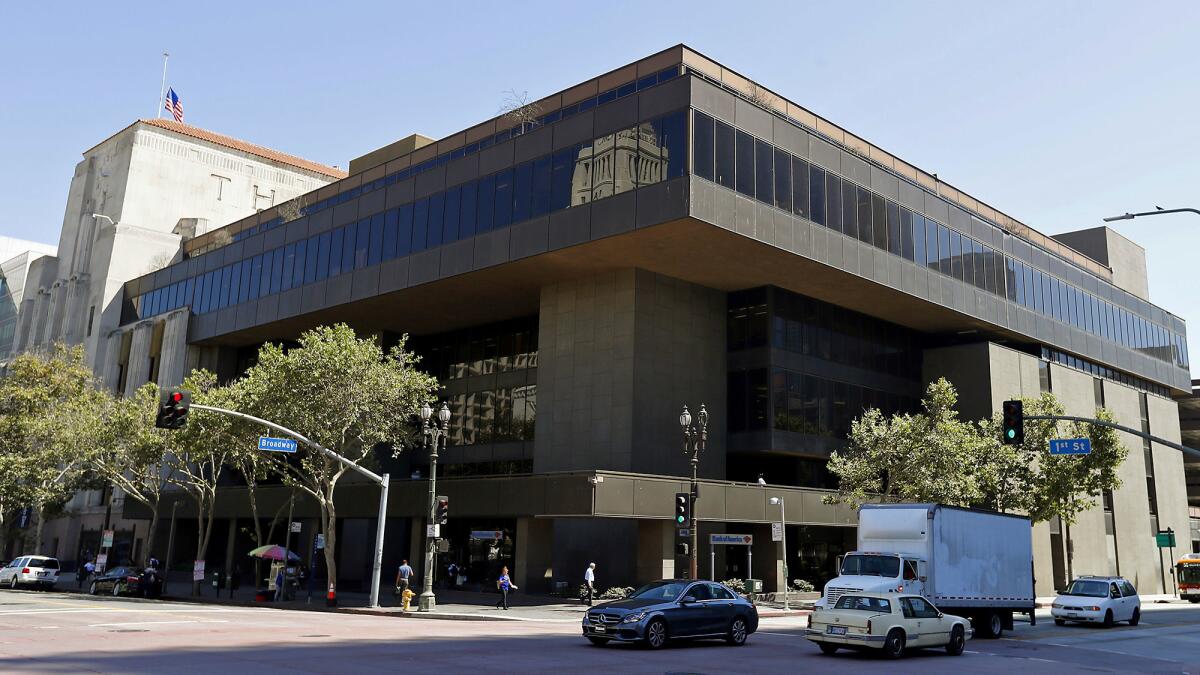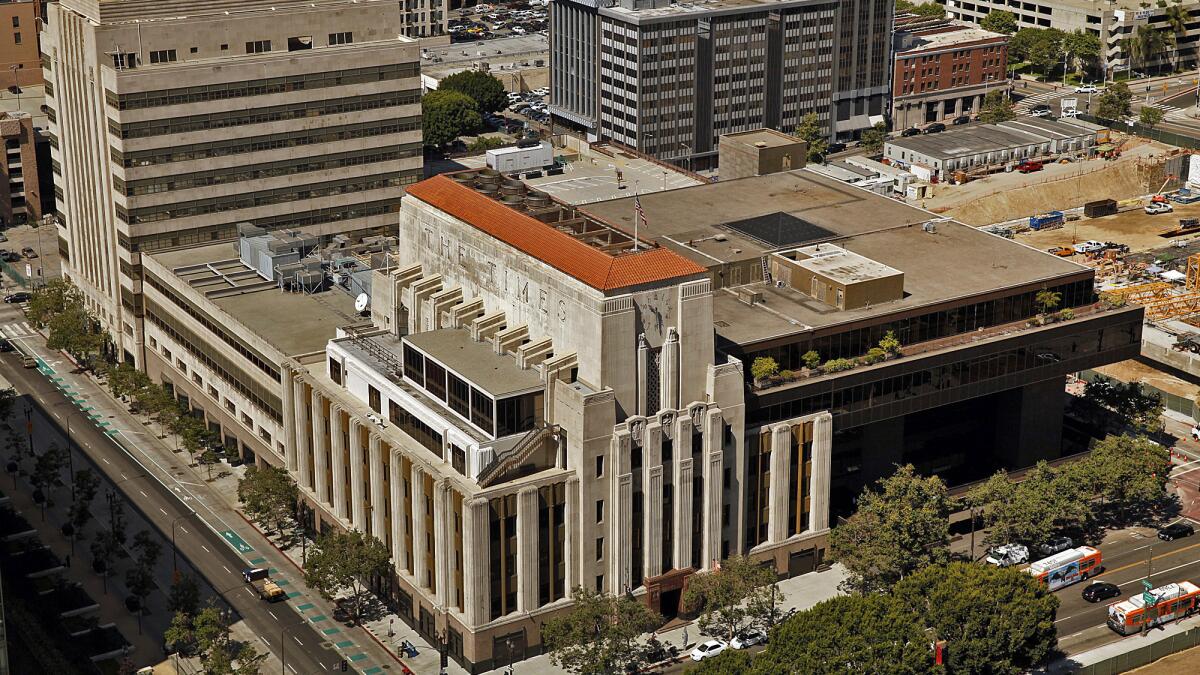Preservationists call for historic status for Los Angeles Times buildings, threatening redevelopment plans

- Share via
Preservationists hope to secure city monument status for three historic Los Angeles Times buildings, which could hinder a plan to redevelop the downtown block where they stand.
City officials last week accepted an application to the Cultural Heritage Commission to officially recognize the buildings, now owned by Onni Group, as historic-cultural monuments and put a temporary stay on demolition and substantial alterations. It will begin formally considering the application this month.
If approved by the City Council, such a designation would not necessarily kill the project, but it could complicate the city approval process and delay any demolition for as much as a year. The proposal is already undergoing a standard project review, according to the city Planning Department.
Onni, a Canadian real estate developer, announced in late 2016 its intention to demolish some structures in the block formerly known as Times Mirror Square to make way for a high-rise residential and retail complex. Onni, which keeps a low media profile, did not respond to requests for comment.
The Times properties — five interconnected structures a stone’s throw from City Hall surrounded by Broadway and 1st, 2nd and Spring streets — were acquired by Onni for $105 million in September 2016, according to CoStar.
The Times, now a tenant of Onni in its historic home, is moving this month to El Segundo, where it will occupy a building owned by Dr. Patrick Soon-Shiong, the new owner of The Times.
Onni’s proposal calls for retaining the oldest of the structures — two Art Deco-style buildings that were constructed on the east side of the block along Spring Street in the 1930s and 1940s. The upper-floor offices would be refurbished, with the ground floors converted to restaurants, shops and a grocery store.
The three structures on the western half — a parking garage, former printing plant and a modern office building — would be demolished to make way for two apartment towers of 37 and 53 stories containing more than 1,100 apartments, a swimming pool and other luxury amenities, as well as ground-floor shops.

The focus of the preservation campaign is the office building, a 1973 structure designed by William Pereira, who also designed the Transamerica Pyramid in San Francisco, CBS Television City in the Fairfax district and the futuristic Theme Building in the heart of Los Angeles International Airport.
Los Angeles preservationist and cultural historian Richard Schave, who is leading the effort, said he does not care if Onni tears down the parking garage at 2nd and Broadway, which also dates from the 1970s — but he draws the line at the Pereira building.
“The Pereira building is the crux of this nomination,” Schave said. “It’s very significant because his building is the least appreciated of the three, and he is a giant of California design.”
If the Times buildings are declared city monuments, the Cultural Heritage Commission can block demolition for as long as six months with a majority vote of its members. The City Council can extend the ban for another six months.
Delays would give the city time to consider alternate uses for the buildings or to encourage developers to keep parts of historic structures intact such as their facades.
Demolition could occur after that if the development is otherwise approved by the city. Onni would also have to address the effects of demolishing the Pereira structure in the development’s environmental impact report.
The Los Angeles Conservancy, the city’s most prominent preservation group, is not formally involved in the campaign but supports the effort, President Linda Dishman said.
She declined to comment further until the review process is underway.
If there is debate, it is most likely to center on the 1973 addition. By contrast, the 1930s building is a popular tourist attraction and the 1940s tower designed by Rowland H. Crawford is noted for its late Art Deco appeal.
But the late-modern-style Times Mirror Building hasn’t elicited the same reverence. Part of that may be the result of Pereira’s reputation, according to architect and historian Alan Hess, who is among the signers of the historic preservation application.
“He had this label given to him that he was Hollywood’s idea of an architect,” Hess said, citing a critic at the San Francisco Chronicle who decades ago zinged Pereira for his good looks, chauffeured Bentleys and steady female companionship.
Pereira was viewed as a “corporate” architect, Hess said, and hence not a serious one in the eyes of critics. Yet he created such famous structures as the Theme Building, the iconic Space Age structure at LAX with its signature crossed arches and circular floor.
“There was bias against big commercial architecture that really undercut his reputation during and after his lifetime,” Hess said. “Now we can look back at his work and see exactly how important it was and his creative ideas in architecture and planning.”
Pereira’s Times Mirror Building was purposefully less dramatic than other buildings he designed in the 1960s and 1970s, according to the application compiled by Schave.
It intentionally does not overwhelm the adjacent building that has been the centerpiece of The Times since 1935 and where a 5 1/2-foot globe anchors the lobby under the stern gaze of the newspaper’s signature eagle statue and busts of former publishers.
(Soon-Shiong has publicly discussed moving the lobby artifacts to The Times’ new headquarters but has encountered resistance from preservationists and city officials who want to see them remain in place for public display. His spokesman declined this week to comment.)
Outside the building, a large illuminated clock tells the time and the newspaper’s name is spelled out in tall neon-lit letters.
The Times Mirror Building next door, by contrast, is a fortress-like building of dark stone and heavily tinted glass that projects authority, the application says.
“Clearly William Pereira’s Times Mirror headquarters is not a common commercial design of the period,” the application says. “It carefully considered its purpose as a symbol of an important corporation, and its site in the city’s civic center.”
Leo Wolinsky, an editor who worked for The Times for more than three decades and contributed to the monument application, acknowledges that the 1973 structure “doesn’t look very historic” yet, but calls it culturally significant as the former headquarters of a national Fortune 500 company that dominated in its field.
“It was there that the Times Mirror Co. took hold and grew, and the powers of the [controlling] Chandler family moved beyond Los Angeles,” Wolinsky said.
Don Spivack, a former administrator of the city’s Community Redevelopment Agency not involved in the application, said monument-worthy buildings should be associated with the city’s evolution.
He thinks the trio of Times buildings fit that bill because of “the long association of the L.A. Times with Los Angeles and particularly downtown Los Angeles.”
“The buildings represent different eras of the newspaper’s evolution and the architectural evolution of Los Angeles,” he said. “Since they’re clustered on one site, it make sense to treat them as a cohesive whole.”
The buildings ended up in Onni’s hands after Tribune Co., The Times’ then-owner, split its publishing and broadcast divisions — and later sold off its real estate assets.
Onni has been a major developer in its home city of Vancouver, helping transform it from a sleepy town to a dense city with soaring glass towers. The company entered the Los Angeles market a few years ago and has already purchased or developed hundreds of millions of dollars’ worth of buildings downtown, including high-rise apartments.
A historic designation would provide some benefits to Onni, which could become eligible for a property-tax reduction under the Mills Act. Such tax savings are to be used to help rehabilitate, restore and maintain historic buildings.
Otis Chandler’s son Harry was a boy when the Times Mirror Building opened in 1973. Not surprisingly, he supports the push to garner monument status for the newspaper buildings.
“My grandmother [Dorothy Chandler] worked with Pereira,” he said, recognizing that the architect had “few good options” if he didn’t want the building to overshadow the iconic 1935 building next door.
“He said, ‘Let’s make a dark void that doesn’t compete with it,’ and that’s exactly what it is. It’s sleek and dark and somewhat mysterious.”
All three structures should be saved, Chandler said, but the building from 1935 designed by Gordon Kaufmann is the one he is most worried about, even though Onni said it intends to keep it intact.
“Developers are wont to change their minds based on market conditions, not preservation needs,” Chandler said.
Onni “is not an L.A. company and they don’t have credentials for caring for historic buildings in our city,” Chandler said. “We shouldn’t leave that to chance.”
Twitter: @rogervincent
More to Read
Inside the business of entertainment
The Wide Shot brings you news, analysis and insights on everything from streaming wars to production — and what it all means for the future.
You may occasionally receive promotional content from the Los Angeles Times.











